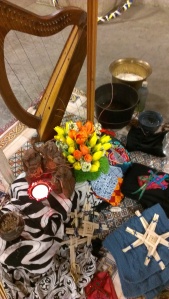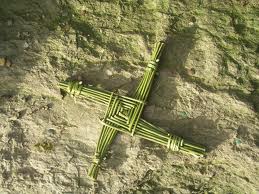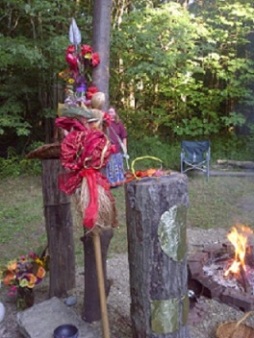I LOVE fairy tales and I love history. While reading ‘Celtic Myths and Legends’ by P.B. Ellis, I stumbled across this gem of a story. I loved this version of the “classic” Cinderella tale so much, I felt I needed to share. This is sooo much better than the Disney version…
I highly recommend checking out his book and the complete telling of this story. The following is my “abridged” story, but this version of the story, and much (most) of the prose that follows, belongs to Peter Berresford Ellis.
Geal, Donn and Critheanach
Once upon a time in ancient Scotland, there were triplet girls born to a Lord of Cataibh. These basically identical sisters were named Geal, Donn, and Critheanach. Soon after they were born , their mother died and the Lord never remarried. This lord was poor, as lords go, and could not afford to hire servants to tend his castle. So the girls grew up without a mothers love, or proper teaching, and the household chores fell to them. Geal and Donn were both very assertive girls, and because Critheanach was the youngest, they made her do all the dirty work about their father’s castle. Critheanach had to clean the kitchen, cook the meals, and do all manner of disagreeable tasks. Indeed, her sisters would not let her go out until the work was done to their satisfaction, and that, of course, was very seldom. They were quite tyrannical towards poor Critheanach.
Every Saturday there was a fair, and Geal and Donn would dress in their finery and go, in hopes of attracting a handsome young husband. One Saturday, after her sisters had gone to the fair, Critheanach heard a knock at the kitchen door. It was a curious old woman, one of the fairy folk, who said she was selling a seun or a charm. Critheanach smiled sadly at the old woman, but told her that she had no money to buy one as her sisters needed all the money in the castle to go to the fair. Baobh, the old fairy woman, asked her why she was not there too-instead of working in the kitchen. To which the girl replied that she had no money, no fine clothes, and besides, if her sisters saw her there they’d beat her senseless for leaving before finishing her chores.
Baobh took pity on the girl and said ‘For clothes I will give you whatever dress you desire, and a fine mare to take you to the fair, with a purse of gold to spend there.’ Critheanach looked skeptical but the old woman demanded to know what dress she would like. ‘A dress of brightest green, a shawl the color of purple heather and shoes to match!’ cried Critheanach with a laugh. ‘It is done!’ cried Baobh. Sure enough, Critheanach was dressed as she had wanted, in clothes so splendid she looked every inch a princess. At the door stood a milk-white mare with a golden bridle and a golden saddle.
Baobh told her that for her part, she must not speak to her sisters or any young man at the fair, and that after an hour she must ride home as quickly as the mare would carry her. This she did, marveling at the fair as the attendees marveled at her. When the bell tolled the hour, she raced home as fast as she could. She had barely reached the door when the horse vanished and she was back in her old clothes-and found that all her chores had been done.
When the greedy sisters returned home, they talked of nothing but the mysterious girl, and demanded that their father buy them new dresses, as they were extremely jealous of the strange beauty.
The next Saturday it happened the same way, except this week she requested a red satin gown, red shoes, and white silk cloak. She once again obeyed the old woman’s terms, and enjoyed the fair, while causing quite a stir among the people, who were sure she was a foreign princess. Once again, the sisters returned home angry and jealous of the mysterious woman, and demanded even more new finery from their father.
The third Saturday, the fairy woman returned and granted her a dress of red silk from the waist down, white silk from the waist up, and a green silk cloak and red shoes to go to the fair, under the same previous conditions. Critheanach stayed at the fair awhile, but the constant attentions of the vain young men had become tiresome, and she was relieved when the bell struck the hour and she could return home, resolving never to go to the fair again for it had lost all its charm.
It just so happened that news of this grand lady had reached the ears of the Prince of Loch Abar, and he had come to the fair to catch a glimpse of her. Prince Duncan saw her and immediately fell in love with her. But she was bound to speak to no young man, and even as he pleaded with her to speak to him, running alongside her horse while she tried to rush for home, she said nothing. He grabbed for her stirrup to stay her horse, but chanced to grab her shoe. He was left behind, standing in the roadway, with her shoe in his hand.
Prince Duncan then boasted to the people assembled that he would find the lady whose foot fit that dainty shoe and marry her. Now the young men were annoyed at this stranger’s presumption as the prince was from a neighboring kingdom, they felt they had first rights to court a lady of their kingdom-not a stranger. One bold young man said that the prince would have to fight them for her. Being honorable, he agreed to do this, if he found her.
For several weeks the prince and his retinue searched the land, finally coming to the castle of the poor lord of Cataibh. When Gael and Donn heard of his coming, they eagerly tried on the shoe. Although they knew they were not the maiden the prince was searching for, they felt they deserved to be married to the prince. Of course, the shoe did not fit either sister, and the prince turned to leave. Luckily, the Lord finally spoke up and said he had one more daughter. When she was brought out of the kitchen, the Prince made one of his servants try the shoe on Critheanach, for he could not lower himself to kneel in front of a dirty kitchen servant. There was an astonished silence as the shoe slipped comfortably onto her foot, for you see, the shoe was made in the Otherworld, and would only accept the foot it was made for.
Then Critheanach stood up, and in a blink of an eye her clothes and appearance were transformed and there stood the grand lady from the fair. The prince fell to his knees and begged her forgiveness and her hand in marriage. But Critheanach had heard of the challenge the prince had accepted from the young men of the village, and told him that if he returned victorious, she would be there waiting for him.
With joy in his heart, Prince Duncan rode back to Dornach. In the square he stood, and beat his sword hilt on his great shield in challenge. Nine of the young champions came forward, and for nine days and nights the combat lasted. Each day a champion stepped forward, and each night his bloody body was carried from the field. At last, Prince Duncan stood and claimed the right to pay court to the youngest daughter of the lord of Cataibh.
When prince Duncan and Critheanach were reunited, they spent a day together in the garden and found they shared each other’s love. So a marriage feast was proclaimed and the feasting lasted for nine days and nine nights.
And they lived happily ever after…
Nope, not yet they don’t. Scottish fairy tales don’t end so easily! There are still the two evil sisters to deal with…
But there were two at the feast who were angered by their sister’s happiness. Their envy and anger turned to hatred, and the hatred became an obsession. After the wedding feasting and celebration, the newlyweds decided to spend some days recovering at a hunting lodge on the coast north of Dornach. A plan was formulated by Gael and Donn to ruin their sister’s happiness. They offered to go with their sister to act as her maids, pretending they wanted to repay their sister for all her hard work and kindnesses over the years, when in fact they went to watch and wait for an opportunity to take their vengeance upon her.
One day, Donn and Critheanach were walking in the garden when Donn caught her cloak on a thorn bush and it was ripped. The wind was high and cold, and Critheanach, being warm and generous, promptly gave Donn her cloak and returned to the house to check on the evening meal. Donn walked on towards the cliffs, wondering how she could take her vengeance on Critheanach, even to the point of murder. Now remember that the three girls were identical twins…Gael came along, with equal wickedness in her heart, and saw Donn standing on the cliff in Critheanach’s cloak. Mistaking Donn for their youngest sister, Gael ran forward and pushed Donn over the edge of the cliff, down toward the rocks and a watery grave.
Satisfied with her work, she returned to the house to find Critheanach in Duncan in each other’s arms, and was horrified when she realized her mistake. When the youngest sister asked Geal where Donn had gone, Gael made up a lie saying that a messanger had come to say that their father was sick, and so Donn left immediately to investigate the matter. Instead of feeling guilt over her murder of Donn, Gael only became more angry and her hatred of Critheanach grew.
The next day, after Duncan had gone out hunting, Geal and Critheanach were walking along those very same cliffs. When Critheanach bent down to pick some wildflowers, Geal seized her chance and shoved poor Critheanach over the edge. But as fate would have it – or perhaps because of the intervention of Baobh – at that very same moment a great whale came swimming along and, looking up, opened his great cavernous mouth. Critheanach landed on his soft great tongue, and was swallowed into the whale’s cavernous belly.
Geal snuck back into the hunting lodge, changed into Critheanach’s clothes, and when Prince Duncan arrived, greeted him with a kiss, pretending to be his wife. When he asked her about Geal, she said another messanger had arrived, their father had worsened, and she had gone to attend him.
Now Duncan truly loved his wife, and although he could not put his finger on it, he was sure that she was not acting like the woman he had married. Prince Duncan was truly in doubt. So that evening, when they went to bed he took his sword and lay it on the bed between them. He said “If you are my true love, then this sword will grow warm between us. If not, it will remain cold.” That night the sword was cold.
The next morning, the prince’s shield bearer, Dion, was walking on the shore when he ran into an old woman – Baobh, the fairy woman. She told him to return to Prince Duncan and tell him the truth of the matter- that yesterday Geal had pushed Critheanach over the edge and she had fallen into the maw of a great whale, where she was safe under enchantment. He could rescue her if he took a skiff and javelin out at noon to meet the whale. He must pierce the red spot underneath its breast fin in order to release his bride.
Prince Duncan readily believes Dion’s story – he knew something just wasn’t right already – and the two go to rescue Critheanach. When the whale saw the skiff containing the prince and his shield bearer coming toward it, it turned to attack, swimming quickly toward them. As the whale rose from the water to crash down upon the small boat, Prince Duncan launched his javelin into the aforementioned spot, under the breast fin. The whale opened his mouth to roar with pain and out popped Critheanach straight into the skiff. Dion turned the boat and raced for the shore as Duncan checked on his wife. She was unharmed, as the spell of Baobh had protected her.
When they returned to the lodge, they found Geal trying on Critheanach’s clothes. Geal knew “there would be no pity for her as she gazed from her sister’s sorrowful but determined face to Duncan’s angry countenance. They made her a prisoner and rode straight back to the house of the Lord of Cataibh.
There was already a suspicion between them that he would not be found ill but was hale and hearty, and that Donn would not be there nursing him. Geal confessed all before her father. Sorrowing, the Lord of Cataibh blamed himself for his daughters’ folly. Yet Prince Duncan pointed out that, inspite of all Geal and Donn had done, Critheanach was also his daughter, and he should be proud of her.
So judgement was passed on Geal. She was cast out to sea on an offshore tide in a small rowing boat, but without oars. She was given enough food and water for a night and a day and left to the fortunes of Manannan the great sea god. It is said by some that she was dragged beneath the waves and became a slave to the Kelpie. Others said that she managed to reach the shores of Lochlann and married a king’s son there and made him unhappy ever afterwards.
As for the Lord of Cataibh, his fortunes began to prosper and he married a fine, handsome woman, who made him very happy.
And as for Prince Duncan of Loch Abar and his wife, Critheanach, they never had a days’ unhappiness in the rest of their long lives, and their children and their children’s children continued to rule Loch Abar for as long as the decendants of Scota and Gaidheal Ghlas, the progenitors of the Gael, prospered there.
THE END
=)
*Ellis, Peter Berresford. Celtic Myths and Legends (2002) (also published as The Chronicles of the Celts, 1999), “Geal, Donn and Critheanach.” (pages 307-319)





















